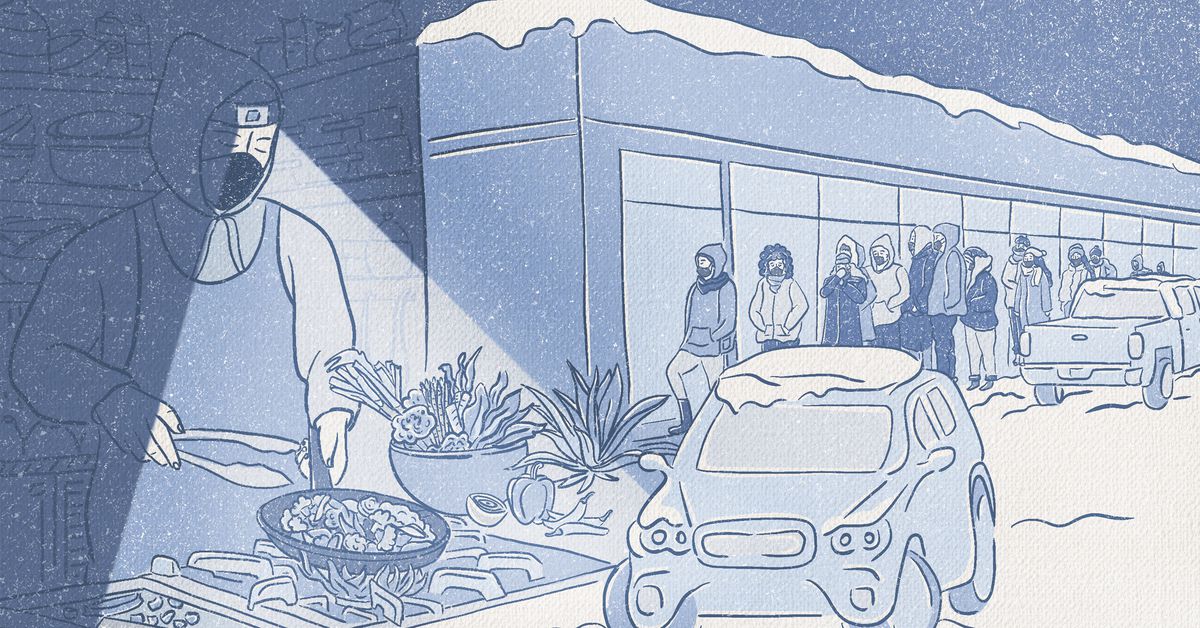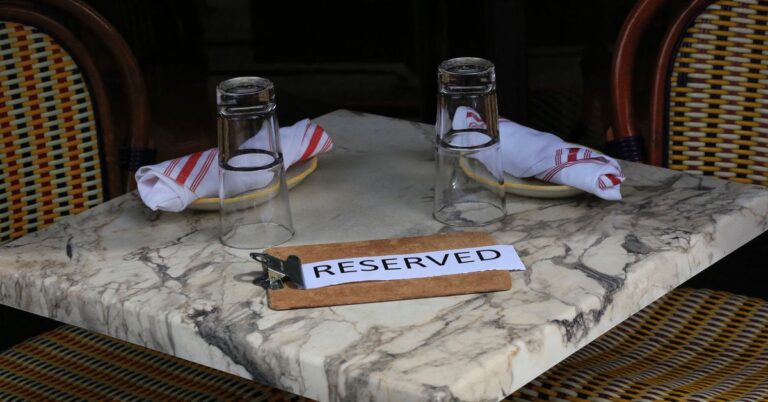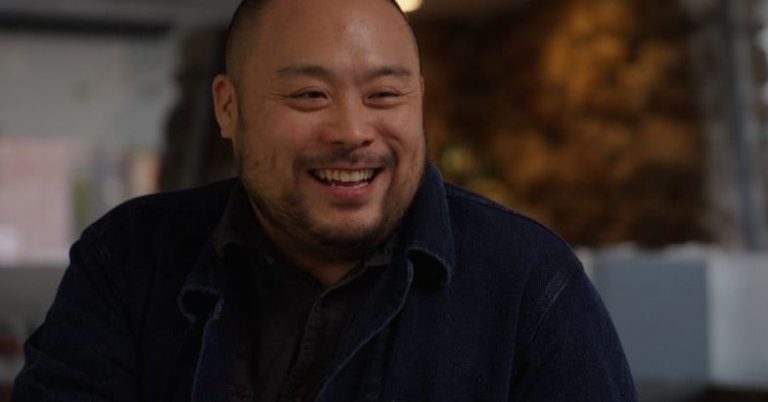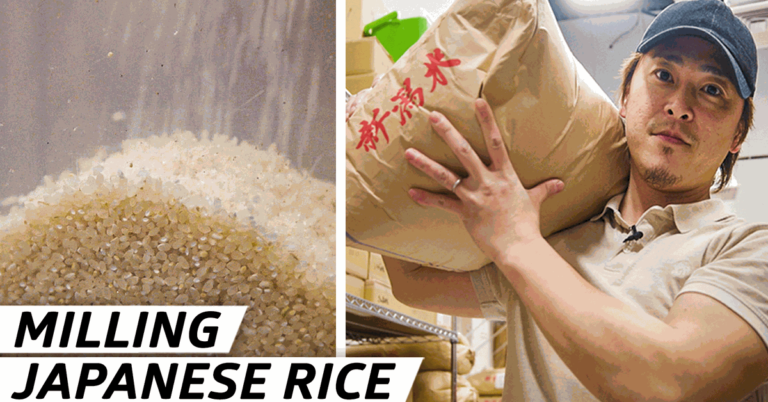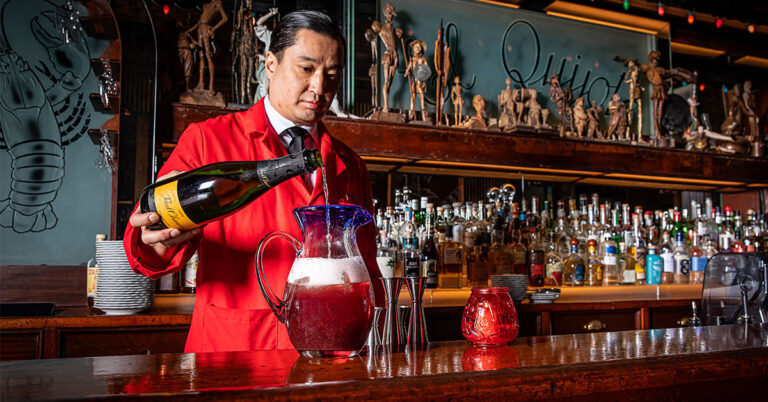How Austin Food Industry Workers Fed the City During Texas’s 2021 Winter Storm
In February 2021, Winter Storm Uri devastated Texas, leaving 246 dead (a number that is likely an underestimation), 70 percent of the state without power, 50 percent without water — and many with a story of survival. Snow, ice, and freezing temperatures hit an underprepared Central Texas, leaving the region immobilized. Thousands of people suddenly didn’t know how to get their next meal. Who could they turn to?
An audit report from the City of Austin on the response to the winter storm found that the city was not sufficiently prepared and didn’t implement recommendations from previous disasters, like developing a staffing plan for emergencies. Furthermore, the report found the city did not communicate effectively with Austin residents in the days leading up to the storm, resulting in confusion for both citizens and on-the-ground city employees.
Austin’s food community stepped up even while navigating its own struggles. At the time, there were some 10,000 new cases of COVID-19 being reported daily in Texas, and vaccines were not yet available to the general population. Restaurants were limited to 75 percent indoor dining capacity to mitigate virus spread, and many of them were betting on Valentine’s Day events for income after a terrible year. Restaurant workers watched those plans dissolve when the storm began and cancellations started rolling in. Still, they were determined to feed people — even if that meant cooking in the dark.
The storm pummeled Austin from Saturday, February 13 through Wednesday, February 17, and the frigid temperatures wouldn’t abate until Saturday, February 20. Even after celebrity chef José Andrés’s crisis team World Central Kitchen (WCK) parachuted in and freezing temperatures relented, restaurant workers continued to provide meals to the large swaths of people who needed them. Eater interviewed some of the people who led the effort to keep Austin fed during and after Uri: A handful of public relations professionals, restaurant veterans, library-associates-turned-city-disaster-responders, and others share their experiences of the Texas storm.
These interviews have been lightly edited for clarity.
Before the storm. Texas Gov. Greg Abbott issued a disaster declaration on Thursday, February 12, but city communications were inadequate and news coverage was more focused on staying off roads, rescheduling vaccine appointments, and possible power outages than obtaining supplies.
Jane Ko, blogger, A Taste of Koko: I think all of [my friends] were like, “Oh my gosh, so exciting, a snow day!” I feel like the city had gently recommended you should get supplies.
Katrina Townsend, Austin Public Library associate and former food unit lead for the City of Austin’s Emergency Operations Center, responsible for feeding anyone in the city’s care, particularly those staying in a hotel, either due to homelessness or to isolate from COVID-19: At Emergency Operations, we knew it was going to get bad. We figured that the food service was probably going to fail at the contracted restaurants [set up to feed those sheltering at hotels]…
We were also supposed to take care of the shelters that [the city] was going to set up, but I never found out where the shelters were until Tuesday, after everything had failed.
Zack Shlachter, Austin Public Library associate, and staffer at the EAT Initiative that provided bags of shelf-stable foods and basic needs, particularly to people experiencing homelessness — a major population served by his library: Ahead of the storm, one of my colleagues [with EAT Initiative] delivered a lot of our shelf-stable food to each of the city’s cold weather shelters. The Friday before the storm hit, we had Adam [Orman] on standby, but we didn’t get our first go-ahead to order meals until Sunday, when it had begun snowing.
The fact that we had this contract with Good Work Austin, so we already had a stable of restaurants that were in a relationship with the city in bureaucratic ways, really facilitated things to come.
After three days of freezing weather, temperatures drop even further to a low of 12°F on the evening of Sunday, February 14, 2021, when snow begins to fall.
Adam Orman, co-owner of Italian restaurant L’Oca d’Oro and founder of Good Work Austin (GWA), an organization that advocates for healthy working conditions for small businesses, including restaurants: It was slick overnight, so a lot of folks had already canceled Valentine’s Day reservations. Getting around was okay up until sunset. I came to L’Oca, picked up meals, and went over to Palmer Events Center [which was being set up as a warming shelter]. It was empty at that point, definitely a skeleton crew there from Austin Public Health and the Emergency Operations Center. On the way back, I could no longer get up the little hill at Sixth and Lamar, and I was in a 4×4. I was fishtailing in that little bit of frozen rain.
I got on the phone with Austin Public Health talking about what we were going to do. They thought Palmer was going to shelter up to 300 people and then they had three cold-weather shelters at either schools or rec centers that were going to temporarily house about 125 people each, and they all needed breakfast, lunch, and dinner.
That night I started reaching out to all the [GWA] restaurants to see who was going to be able to get into their restaurant.
As the snow continued on Monday, February 15, the demand for electricity overloaded the power grid, causing it to fail across Texas.
Jane Ko (A Taste of Koko): We did wake up to a snow day on Monday, and I think everyone had fun. Then, we started hearing about some people losing power. Then it became: A lot of people are losing power and neighborhoods are going out.
Joe Carr, former general manager of Easy Tiger, a GWA partner: Monday morning, I was like, “I can just drive to Easy Tiger and make something happen.” I’m from Michigan, so I was a little naive. It was like an apocalyptic nightmare — there were cars sideways and backwards and upside-down.
I told my employees, “Guys, I need help getting food somewhere,” because it was just sitting in our fridge. Adam reached out and asked what we could do, and I luckily had some super selfless staff and people that were ready to help.
We all committed to our own safety. We had 20 staff members show up, even people’s dads. We quickly shifted the interior of Easy Tiger into a packing facility for food. Luckily, we had power, so we were able to cook and keep people warm.
Adam Orman (GWA): On Monday, I started reaching out to all the restaurants that were already working with GWA to see who was going to be able to get into their restaurant. Nobody was getting deliveries. I pulled up outside of [fast-casual salad restaurant] Baby Greens, and [owner Sharon Mays] was able to empty her walk-in cooler into my car. Antonelli’s emptied out their entire cheese cave and filled an entire SUV with cheese that I brought to a hospital. Colleen’s Kitchen had meals they had already prepared, but they couldn’t drive anywhere, so I was able to deliver those meals for them. And Fiore [Tedesco, chef and co-owner at L’Oca d’Oro] was doing the same thing.
On Tuesday, the list of places that needed food had expanded because of the power and water outages. But the list of suppliers wasn’t getting any bigger. People were waiting in line at the restaurant depot for eight hours, and not getting any food to be able to cook anything.
Joe Carr (Easy Tiger): I was texting with Adam every five minutes. He would just rifle off orders and locations, and we would make a menu in the moment and try to make it as healthy as possible for everybody — because it’s easy in those desperate times to just eat bags of chips.
Katrina Townsend (Emergency Operations): We couldn’t figure out at first where we could even get the food. We contacted some restaurants whose food we thought wasn’t going to last for several days, and we purchased the ingredients.
:no_upscale()/cdn.vox-cdn.com/uploads/chorus_asset/file/23247863/Baking_at_Easy_Tiger_Agostina_Vidable.jpg)
I would call a restaurant and say, “What can you sell me for $2,999.99?” because that would keep me from having to make a contract with them. (The city suspended the rules for contracts, but I didn’t know that until after.) They would sell me ingredients, then I would get a box truck, and one of the Street and Bridge guys would throw down sand in front of that truck so that it could get to the restaurant. We’d load up, take it to the shelter, and then the police that were stationed at the shelter would cook the food and distribute it to the people there.
Art Goldstein, owner, Southside Flying Pizza: Pipes were breaking all over the place. I had bought a new hot water heater for my house, but I had to take it to the restaurant and install it there myself because the one in the restaurant broke, and that was more important.
PR professionals Chelsea McCullough, Jane Ko, Cara Caulkins, and Kristy Owen began organizing their own relief efforts on Monday, February 15. The group connected with over a dozen sponsors and organized a GoFundMe campaign to help pay restaurants to provide meals to the community.
Chelsea McCullough, owner, Mylk Communications: We were realizing people don’t have access to food, water, heat. My clients were calling me saying, “We’re losing Valentine’s Day sales. What do we do?” Then, Cara called saying, “Hey, I have an opportunity with Deep Eddy Vodka, they want to sponsor some restaurants to provide some meals.” There wasn’t necessarily a plan.
Jennie Wait, associate field marketing manager, Deep Eddy Vodka: On Tuesday, we contacted our restaurant partners to see if they could get to the restaurant and then said, “Okay, we have X amount of money to spend. Can you make 100 pizzas?” And we would just post on our Instagram: “The first 100 people to show up get free pizzas.”
We also posted on Instagram asking who needed help. We got flooded with requests — people DMing us saying, “Can you get water to me?” We had a massive spreadsheet that had the person’s name and location and what they needed. We ransacked our office, taking blankets, snacks, anything we had there, and delivering them to anybody we could get to.
Art Goldstein (Southside Flying Pizza): I had power and water at [the] South Congress location. So there was me and another fella, we opened up and cooked whatever we could. We rapidly learned that the only way to make it work was not to use a phone or the computers or anything to take orders, just run it like you would if you were at a festival. We charged for $10 pizzas — cheese or pepperoni. Hundreds of people showed up.
Then, the donors came in. There was enough that we could go take it to the hospitals, to neighborhoods where people were trapped, and to lower-income communities.
Cara Caulkins, owner, Cara Caulkins Communications: When these natural disasters happen, people in lower-income communities suffer the most because they don’t have the back stock of supplies. But in this case, what was really interesting was that everyone was really affected, because people were so unprepared. I think it was very humbling for a lot of people because it was the first time they’ve ever had food insecurity in their life.
Chelsea McCullough (Mylk): After Tuesday, February 16, we had run out of funding [from Deep Eddy], and that’s when Cara brought in some additional funds from Kendra Scott and Bumble. But the need for the meals was so great that [restaurants] were running out of food.
Jane Ko (A Taste of Koko): I set up a GoFundMe on Tuesday, February 16 [to fund meals from restaurants for anyone affected by the storm]. Our original goal was $10,000. We raised that within the first three hours. The first night, we hit $20,000.
Chelsea McCullough (Mylk): We had so many restaurants stepping up. But there were also challenges: Can we get staff there? Do they still have refrigeration? Is all the food ruined? I would say 80 percent of the restaurants that I asked in those first really treacherous days weren’t able to help.
Jane Ko (A Taste of Koko): I lean on restaurant owners that I have close relationships with, like [Eric Silverstein of] the Peached Tortilla.
On Wednesday, Eric picked up his cook in the snow and went to the Peached Tortilla. They called me from the restaurant saying, “Jane, we have an issue. The restaurant’s power is out, but luckily our burners are on gas.” The two of them cooked in the dark for two hours, hundreds of meals that they passed out to the community. He told me later, “I wish you were here, people were crying because they haven’t had hot food for two days.” They washed dishes in the dark for another hour and a half after that.
The city set up warming shelters around Austin, but as quickly as one became operational, the building would fail. The city would often send supplies to a shelter only to find that it had been moved to another location. The two biggest shelters were the Palmer Events Center and the Millennium Youth Complex. Palmer officially served 845 people over the course of the freeze.
Katrina Townsend (Emergency Operations): We were covering the Palmer Events Center. At some points, there were about 500 people there. The restaurants delivering for us didn’t have trucks big enough to carry those 500 meals, so they would show up with 200 meals and then go back to pick up the rest. Some of the people [staying in the center] became adversarial because they were fighting for supplies. Raising Cane’s saved us — I think the manager was stuck there, and I would order 500 meals from her at a time. It really helped when we could get a box truck to go pick up the 500 meals from Cane’s and deliver them. It gave everybody a hot meal and the tension ratcheted down.
Zack Shlachter (EAT Initiative): Folks on the ground from some of the warming centers were saying that the food was literally keeping the peace.
Adam Orman: Palmer was amazing. I delivered meals a couple of times and their setup in the auditorium space was just tables and boxes of food as far as the eye could see.
Joe Carr (Easy Tiger): Millennium was a whole other ballgame — you couldn’t get enough food out there. I don’t remember what our total number was, but it was probably close to 20,000 meals throughout those few days. You have to remember that we’re making all these meals while we’re trying to be six feet apart with masks on and using sanitizer.
In addition to the warming centers, Austin’s Emergency Operations unit handled other aspects of the relief effort, including feeding first-responders, and fielding 311 calls and requests for help from the Red Cross.
Katrina Townsend (Emergency Operations): I had to take care of 100 meals at the police stations and substations. We also had to cover the Street and Bridge departments — the guys that actually throw down the sand on the ground — and feed them.
We also took care of tickets that were coming from 311. Elderly people would call in saying, “I’m trapped in my house, I don’t have any water, I don’t have any food.” The Red Cross would come to me and say, “I have a family of 14 in Giddings, and they haven’t eaten in two days.” We covered all the way out to Bastrop, Giddings, and other places that didn’t have their own emergency services.
I don’t actually know who was supposed to feed the community at large. And I think that’s why it feels like, to some citizens, that [the city] just kind of left them there — because there wasn’t anything between the shelter and the community.
Bryce Bencivengo, communications manager, City of Austin: In previous disasters, we fed people who are in our care — in our sheltering system. We have nonprofit partners and private-sector partners that step up for mass feeding: Central Texas Food Bank, H-E-B, and Austin Disaster Relief Network — they’re the Voluntary Organizations Active in Disaster that traditionally help with feeding people who are not in our care, for example, if their kitchen was destroyed by a flood or their utilities are out so they’re not able to cook.
During Winter Storm Uri, some of these providers had challenges and the scope of the need was really great in the city. So we worked with the Texas Division of Emergency Management and FEMA to provide meals ready to eat (MREs).
We distributed about 125,000 MREs during Winter Storm Uri. We gave out another 50,000 to groups to give out and those were from a limited cache that we had on hand that was largely provided by the state and federal governments.
Sourcing and distributing meals was a stressful, round-the-clock job.
Adam Orman (GWA): We were coordinating the distribution of up to 7,000 meals a day. The conversations starting on Wednesday, February 17 were with sponsors like Indeed and Whole Foods Foundation that wanted to help. I would say, “We’re paying local restaurants $5 a meal. If you can sponsor up to this amount right now, this is what our need is.” I started talking with the person at WCK [José Andrés’s disaster relief organization] and coordinating with them. They were able to help organize the restaurants, and bring in other restaurants. On the back end, they were able to provide a lot of funding.
:no_upscale()/cdn.vox-cdn.com/uploads/chorus_asset/file/23247864/Warming_Center_Agostina_Vidable.jpg)
Chelsea McCullough (Mylk): I remember one day, I woke up at 4 a.m. with a request from WCK to help them source 10,000 meals for the Millennium by 4 p.m. that day. [I was working so much that] I didn’t even physically get up from my bed for 16 hours — my phone was ringing off the hook.
Joe Carr (Easy Tiger): I was working close to 20 hours a day. We would get to Easy Tiger as early as we could. We wouldn’t stop until we knew people were done driving on the roads because people would come in at all times of the night and knock on the doors looking for food; we would stay to make sure that someone was there to take care of them, and we would try to get our staff home before it was too dark so they could drive safely.
Adam Orman (GWA): I was on so much adrenaline. I was working by 5:30 a.m. and would realize at noon that I hadn’t moved from my computer, iPad, and phone. But the time was flying by because there was so much in terms of coordinating with WCK, coordinating Austin Public Health, etc.
We had power at my house the whole time, but we didn’t have water for a couple of days. I was so anxious that I was missing texts. If I had a phone conversation for more than five minutes, there were going to be 30 texts that I was going to need to try and follow up on. I only slept a couple of hours the first two nights, but I have kids, so I’m used to that.
Chelsea McCullough (Mylk): The lack of organization around communications in an emergency disaster situation like this was scary to me. We’re just regular Austinites. I never at any point said, “I’m signing up for this.” We were put in this position because we have the contacts and the resources to get food to people. But I also know that the city does. So where are the people in power that we would think would be there for us at a time like this?
Katrina Townsend (Emergency Operations): I feel personally responsible for every person that was calling and saying they need help. And it was heartbreaking because I didn’t have the adequate supplies to take to them. And if I did, then I couldn’t find them.
The people in operations were there Monday through Sunday straight. They didn’t go home, they just slept in shifts on cots.
By Wednesday, February 17, grocery stores began to open again, with hours-long lines and limited supplies. By Friday, February 19, when a federal disaster was declared, temperatures were in the 40s, and most people had regained power — although for many, like those with burst pipes, the true scale of the destruction was only just becoming apparent.
Chelsea McCullough (Mylk): Once it got to the point where most people had gotten access to food or power and water, there was still a humanitarian crisis going on, even when temperatures got up to 70 degrees. A lot of people in East Side housing don’t have access to transportation and weren’t able to get to the Millennium. We were actually organizing a database of specific apartment complexes and dropping off food there.
I remember one day there was a woman crying on the phone saying, “We’re drinking the pool water.” I was just sitting on the Zoom thinking, This is so much bigger than all of us. And also, Where’s the city?
Katrina Townsend (Emergency Operations): When [stores did receive] supplies, our credit cards failed, because some of the places we had purchased from read it as fraud. I had six credit cards, and none of them worked. People started trusting us to pay them.
Costco let us take things without paying because we only had one kind of credit card and they didn’t accept it. But they let us take water and food.
We’re still trying to pay some of these people that gave us food [as of January 2022]. But that’s how it is when you operate with the government.
Adam Orman (GWA): Nobody was getting paid. They were going to invoice WCK after the fact. I was really proud of our restaurants. Nobody was asking for money, even in the middle of the pandemic. They were looking to help, especially locally owned places. There were a lot of people doing whatever they could to help their neighbors.
Efforts to feed the community did not end until weeks after the storm — and then, reflections began on what went wrong and how to improve. A city report on the crisis listed 132 recommendations for improvement.
Adam Orman (GWA): Council Member Greg Casar did a distribution event at Garcia Middle School on Thursday, February 25. We were giving people boxes of 10 meals. The line of cars was out of the parking lot, down the block, and around the corner — still, after a week and a half.
We officially ramped down on February 28. Through the end of April, we were still delivering meals to a few apartment complexes sporadically, because they were still without power or gas.
Katrina Townsend (Emergency Operations): Normally, logistics and operations handle emergencies that last a couple of days to three weeks. Everything we were running into recently had dragged on for months. We would be taking care of three or four different emergencies all at the same time.
[The city is] trying to hire permanent people — they don’t have any permanent people that do logistics. Every city department just gave whoever they had. If you do that, then every time you have an emergency, you have a new group of people.
Jane Ko (A Taste of Koko): We raised over $150,000 in one week and provided over 40,000 meals to the city. [We fed] all major hospitals, EMS, low-income housing, and supported about 35 restaurants at the same time. We donated the remaining $56,820.94 in funds to WCK.
I was on several Zoom calls with city council members three weeks after the storm. Most of them were like, “How did you do this? How big is your team?” I was like, “Look, we’re just unpaid volunteers that care a lot about the community.” There were legit conversations [with government agencies] like, “We need to figure something out internally, because we can’t have Jane Ko step up every time.”
Joe Carr (Easy Tiger): [Restaurants] shouldn’t be [pushed] to a point where we’re having to desperately raise money in the moment in order to get the basic survival needs [met]. The restaurant industry needs help securing those funds.
Adam Orman (GWA): Crises are hard. The whole point is that you’re reacting to something that you didn’t expect.
We learned that the food bank model is limited. Folks literally couldn’t open the food bank — they had no power, so their loading dock wasn’t working. And you can’t get people to one centralized location if people can’t get places. Having a spiderweb network of places that can provide food makes a lot of sense. On the one hand, I want it to be restaurants, but it should also be a few city-run hubs that are able to stand up in the case of an emergency.
Jane Ko (A Taste of Koko): The thing I heard the most out of the thousands of people DMing me that week was: “Thank you so much for doing this because if you didn’t, I don’t know who would — and because you did, you inspired all the rest of us to do something.” That’s something that I didn’t really think about. I think this is what makes Austin so special.
